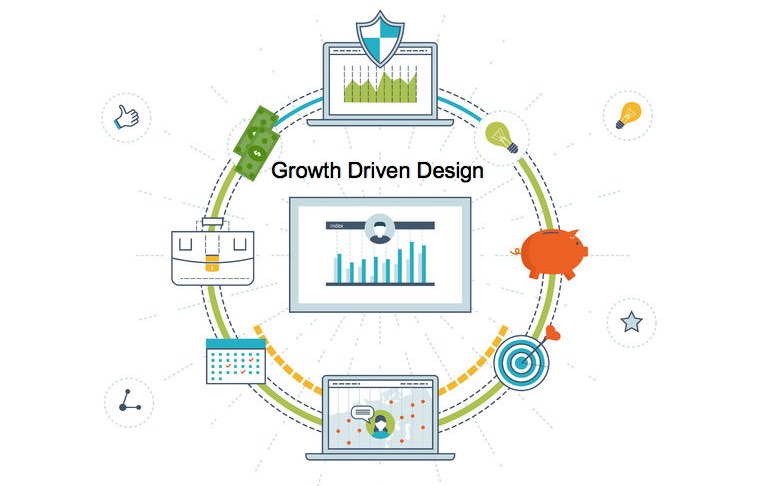
The days of “set it and forget it” website design are over—at least for those companies that want the agility to respond to market conditions and customer demands. Move over, traditional website design, and make room for growth-driven design, a new and smarter way to build a website. No one has time or money to waste on behemoth website designs, especially if they’re not generating more revenue on a regular basis.
Growth-driven website design takes into account the natural obsolescence of typical website design and pairs it with marketing and sales goals to be more effective. Growth-driven website design is backed up with data which makes it almost foolproof in terms of engaging more prospects, converting them to customers and improving revenue. And what’s great about growth-driven design is that the investment generates business growth all the while becoming stronger as you keep an eye on analytics and take action to continually improve.
You can’t argue with the facts, especially data specifically focusing on your website activity. Before you begin a growth-driven website, you’ll want to run some analytics to get a better understanding of what’s working and what could use some improvement. Then you can build a smart web strategy based on facts, not assumptions as in traditional website design.
What kind of performance are you looking for from your website? Do you need to generate more qualified leads? Are you just looking for more traffic? Do you need to ramp up conversions? Get your goal firmly in mind before proceeding to design because it will help you develop a smarter site. It is important to clearly understand your market and competitive position before creating any website page. Don't think of your website as one big monolithic representation of the entirety of your business. Instead think about each set of messages you want to communicate and create topic clusters around each of them. Set goals for each message thread and measure the results against key performance indicators for each message flow.
In order to achieve your website goals, you’ll need to define buyer personas and content strategies for each so you can target appropriately. You should know who your customers are and who you want to add to your list. Focus on those buyers. What are they looking for? How can you meet their needs? How do you communicate with them on your site? Don’t worry about trying to please everybody who may land on your page. Your message and products won’t be for everyone. Simply focus on those who will identify with your brand story and have potential to buy your products or solutions. Create a content strategy that is aligned with each of your ideal prospect(s) and the problem(s) they need to address.
Re-visit your goals for your website briefly. If they don’t include generating more revenue, edit them now to include it because that’s what growth-driven website design does beautifully. Getting there will include a series of fixing problem areas, introducing new elements and, of course, running the analytics repeatedly to refine. Be sure to map out the information flow and envision how a prospects will traverse your website pages. Think about the conversion paths of each visitor (buyer persona) and the information they should consume in what order.
52% of website viewers decide not to buy from a website because of poor navigation and overall lackluster aesthetics. Who can afford to lose that many visitors and potential buyers? We live in a time off short attention spans. Don't lose prospects because of simple errors.
So, what can you do to make your website design more engaging and productive? We’ve identified some top-level ideas to get you started and share them here.
These are just a few design elements that can dramatically impact the effectiveness of your website. Working with professional designers proficient in growth-driven design will put your website in a completely different category and will rocket your business performance. Just remember to run the analytics on a regular basis and adjust accordingly.
Not just any analytics will do. The analytics must be able to provide detailed behavior maps of individuals on your site. Aggregated data like what Google Analytics is not sufficient to enhance the performance and conversion rates for a website.
Build your website on a Content Management System (CMS) that enable you to easily make changes to the site. Many website themes also enable rapid development of new pages without coding once the theme is in place. You will want to be very nimble and responsive based on what you learn once the site is live.
The key realization is that the internet is constantly changing. You and your competitors are continually adding content and engaging in social media. The more the internet content changes, the more your results will change. Architect the pages correctly for engagement and continually publish new content on your blog and website pages so your business gains favor with search engines while being engaging to visitors. Want to learn about how to attract and convert website visitors into leads, then download the free eBook - The 8 Steps to Attract Qualified Leads for your Business.
Bristol Strategy is a full funnel inbound marketing agency and inbound sales agency offering the full complement of Inbound Marketing services that enable our clients to surpass their business objectives by transforming the way they engage with their buyer on-line. Reach out to us to learn more about how our experience and capabilities can help your business grow.
Image Copyright: 123RF Stock PhotoAsk us about our unique approach that creates a full-funnel "inbound" engagement model for your business that attracts and converts digitally engaged prospects.